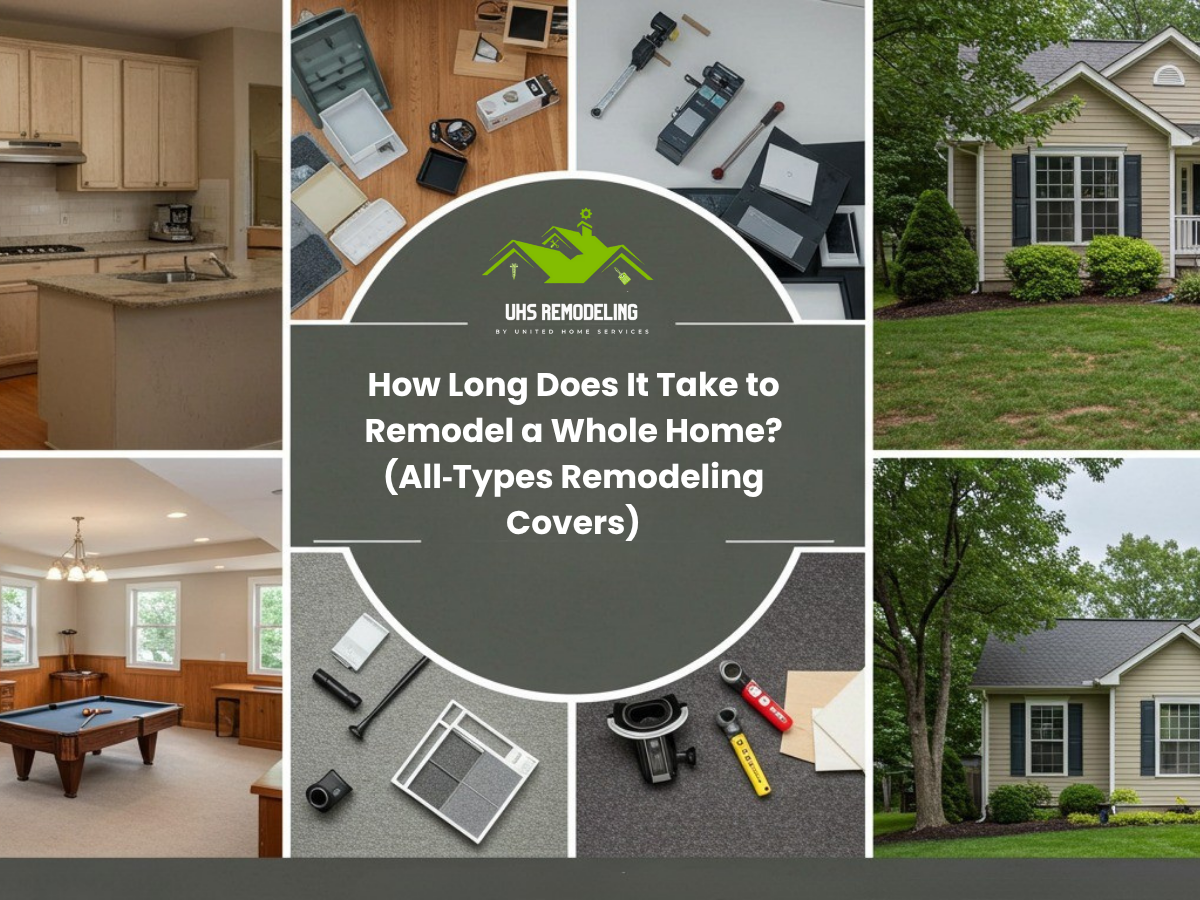Remodeling an entire home transforms spaces, but how long does a full‑house renovation take? For most homeowners, the answer depends on the type of project, the remodeling process, and the professionals involved in the project. Whether it’s a basic cosmetic update, a turnkey renovation, or a full gut-and-rebuild, timelines vary greatly.
According to HomeAdvisor, the average whole‑home remodel takes between 4 and 9 months, but this range can stretch depending on complexity, permit timelines, and contractor availability.
In this guide, you’ll learn:
- Different remodeling types
- Detailed renovation phases
- What affects your renovation timeline
- How budget and choices impact speed
- When to DIY and when to hire experts
Let’s begin by exploring the various remodeling paths available to homeowners.
What Types of Whole‑Home Remodeling Projects Exist?
A whole‑home remodel can be as simple as fresh paint or as complex as tearing down walls and rebuilding interiors. Options include cosmetic remodels, structural renovations, full-scale ADU construction, and home additions. Options include cosmetic remodels, structural renovations, full-scale ADU construction, and home additions contractors in Plano.
Each project type has its timeline, budget, and scope of work. Knowing the differences helps you prepare for both the process and duration.
Here’s a breakdown of what each project typically involves.
1. Cosmetic & Non‑Structural Renovation
A cosmetic renovation is the most surface-level type of remodel, focused on visual updates that don’t change the structure of your home. Common tasks include repainting walls, installing new flooring, replacing light fixtures, upgrading hardware, and switching out countertops or cabinet fronts. These projects generally take 4 to 8 weeks, depending on your contractor’s schedule and material delivery.
This cosmetic renovation timeline is ideal for homeowners seeking a refreshed look with minimal disruption and lower costs. Explore more renovation ideas in our Increase Home Value with Renovation guide.
2. Full‑Structural Renovation (Gut & Rebuild)
A full-structural renovation includes removing walls, reworking layouts, replacing framing, installing new electrical, plumbing, and HVAC systems, and bringing everything up to modern building codes. The process typically takes 6 to 12 months and often involves multiple rounds of code inspections and permit approvals.
This type of renovation is ideal for aging homes, reconfiguring layouts, or transforming outdated spaces into open-plan designs. It requires planning, patience, and the expertise of an experienced contractor for home renovations.
→ Download our Permit‑Ready Planning Checklist before starting.
3. Additions & ADU Construction
Adding square footage to a home through a home addition or creating an Accessory Dwelling Unit (ADU) is a major project that involves excavation, foundation work, framing, roofing, insulation, plumbing, and full interior finishing. These projects usually take 4 to 9 months and depend heavily on your city’s permitting process and zoning regulations.
ADUs are increasingly popular for multi-generational living or rental income, especially in states like Texas, where ADU regulations are evolving.
Start with our Breathe New Life into Your Plano Home guide to see how additions can redefine your living space.
What Are the Key Phases of a Whole‑Home Remodel?
Every whole‑home remodel follows essential phases. Understanding these allows for more accurate planning and fewer surprises. Whether your renovation is cosmetic or structural, the flow remains consistent.
Here’s a detailed breakdown of each renovation phase:
- Design & Permits (4–12 weeks): This stage involves concept planning, selecting materials, finalizing layouts, and obtaining permits. Delays in permit timelines often extend this phase.
- Demolition & Structural Work (4–8 weeks): Once permits are secured, demolition begins. Walls, cabinetry, flooring, and outdated systems are removed. Structural framing is repaired or reconfigured.
- Rough‑In (2–6 weeks): Behind-the-wall work begins electrical, plumbing, and HVAC systems are installed. This step ends with inspections to ensure safety and compliance.
- Finishes (4–12 weeks): New walls go up. Trim, tile, cabinetry, paint, and flooring are completed. This phase varies based on the complexity of the finish and the subcontractor’s timelines.
- Punch List & Final Inspection (1–3 weeks): Minor fixes and touch-ups are handled. A final walkthrough ensures quality and compliance with building codes.
→ Organize each step with our Whole House Renovations Challenges checklist for smoother project management.
What Factors Affect Remodel Timelines?
A home renovation’s duration depends on more than the scope. Multiple internal and external factors influence the remodeling timeline, and overlooking any of them can result in frustrating delays.
Here are the key influences:
- Permit Delays: Cities often experience backlogs, particularly after weather events or during periods of intense building activity.
- Material Lead Time: Custom fixtures, imported stone, or cabinetry can take several weeks to several months to arrive.
- Weather Conditions: Rain, snow, or extreme temperatures can halt outdoor work, such as roofing or foundation pours.
- Subcontractor Availability: Skilled tradespeople are often booked months in advance. Misalignment in scheduling can cause gaps.
- Homeowner Decisions: Late-stage design changes, indecision on finishes, or added scope mid-project often result in delays.
→ Avoid surprises by checking out our Living in Your House During a Remodel tips to keep projects on schedule.
How Much Does It Cost and How Does That Affect Time?
Your project budget has a direct impact on the timeline. Generally, the more money invested, the more complex the project, requiring more time. Lower budgets often mean simpler scopes and shorter timelines, but may also mean fewer features or basic materials.
Here’s how budget aligns with duration:
|
Budget Range |
Project Scope | Expected Duration |
Notes |
| $50k–$100k | Cosmetic refresh | 1–2 months | Quick upgrades with minimal demo |
| $100k–$250k | Kitchen/bath remodel + cosmetic | 3–6 months | Mid-scale updates with multiple rooms |
| $250k+ | Structural + ADU/full home overhaul | 6–12+ months | Includes permits, inspections, ADUs |
Your timeline depends on how much work your budget allows and how much flexibility you build into the plan.
→ Ready to start budgeting? Get in touch with best home remodeling contractors for expert consultation.
Should You Hire a Professional Remodeler or DIY Portions?
Many homeowners ask if they can DIY some parts of a renovation to cut costs. The answer depends on your skills and the scope of work. Simple projects, such as painting, hardware replacement, or minor tiling can be done yourself. However, structural work, electrical upgrades, and anything involving permits should be left to a licensed contractor.
Pros of Hiring a Professional:
- Expertise with permits, timelines, and code
- Faster project completion
- Fewer safety risks and insurance issues
Cons of DIY:
- Risk of costly mistakes
- Project may stretch longer than expected
- Might void warranties or insurance
Choose a hybrid model, DIY where safe, hire pros for the rest.
→ Contact UHS Remodeling for flexible, professional solutions tailored to your remodel.
How to Plan Your Timeline Efficiently?
Efficient project planning is the secret to an on‑time whole-home remodel. These seven strategies can help avoid delays, reduce stress, and improve contractor coordination:
- Build a Time Buffer: Always assume permits and material deliveries will take longer than expected. Pad each phase with 10–15%.
- Consolidate Trade Work: Schedule subcontractors by group to minimize repeated visits, e.g., complete all plumbing tasks simultaneously.
- Order Materials Early: Place orders for tile, fixtures, and appliances during the design phase, before demolition begins.
- Use a Gantt Chart: A visual map of project phases keeps everyone aligned and aware of dependencies.
- Track Weekly Progress: Hold regular meetings with your contractor to identify and address small delays before they escalate.
- Hire a Dedicated Project Manager: Either from your contractor’s team or as an external hire, this person keeps trades, timing, and materials on track.
- Stay in Constant Communication: Proactive updates between you and your builder help avoid assumptions and last‑minute changes.
Stay organized with our home remodeling in Little Elm guide for expert timeline planning and project tracking.
FAQs About Whole‑Home Remodeling Timelines
1. How Long Does It Take to Remodel a Whole Home?
A whole-home remodel typically takes between 4 and 10 months, depending on design changes, unforeseen issues, permits, weather, and the project’s scale. Minor remodels with limited structural work can be completed in 2–4 months, while full renovations with additions may take more than 12 months to complete.
2. What Are the Fastest Remodeling Tasks That Save Time?
Cosmetic remodels, such as repainting, hardware upgrades, lighting upgrades, and basic tile or flooring changes, are among the fastest remodeling tasks that can be completed within a month. These updates have minimal structural impact and do not require permits, thereby speeding up the completion process.
3. Can I Remodel My Home in Phases to Save Time?
Yes, you can remodel your home in phases to save time and money. It allows you to focus on a specific area and avoid complicating the project. Phased remodeling can help homeowners break a large project into smaller, budget-friendly phases.
4. What Delays Home Remodeling Projects the Most?
The home remodeling project is delayed due to poor planning, unexpected issues, weather disruptions, material delays, and mid-project design changes. A detailed pre-construction plan and fixed decision-making minimize project delays.
5. Do I Need a Permit for Every Part of My Remodel?
No, you do not need a permit for every part of your remodel. Typically, lengthy projects involving framing, walls, plumbing, electrical systems, structural changes, or changes in square footage usually require permits. Minor cosmetic updates, such as painting and repairs, usually do not require permits.
6. Should I Hire a Remodeling Contractor or Handle Some Parts Myself?
Whether you should hire a best remodeling contractor or handle some parts yourself depends on the scope of the project, your skills, and your comfort level with risk. Professionals are recommended for complex projects which include structural, electrical, and code-sensitive work.
7. How Can I Plan a Realistic Remodeling Timeline?
You can plan a realistic remodeling timeline by clearly defining the project scope and budget, then creating a detailed schedule with phases, milestones, and contingency plans. Include a 10–20% buffer time for unforeseen issues.





